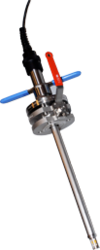Dissolved oxygen is required for the survival and growth of many aquatic organisms, including fish. The concentration of dissolved oxygen may also be associated with corrosive and photosynthetic activity. The absence of oxygen may permit anaerobic decay of organic matter and the production of toxic and undesirable esthetic materials in the water. Main applications for this sensor are biotechnology, chemical industry, air surveillance, fish farming, water management and sewage water (gas and liquid phase).
The Visiferm utilizes luminescent technology and eliminates the typical drawbacks of membrane components. The measurement is unaffected by sample fouling or poisoning and virtually maintenance free with no membranes to replace, no electrolyte solution to replenish, no anode or cathode to clean or replace and long calibration intervals.
Features
- suitable for steam sterilization, autoclavation and CIP
- flow independant; self diagnostics
- electrolyte-free so no leakages occur
- no membrane so no concerns about air bubbles
- no polarization time required
- easily replacable sensor cap containing the sensing element
- replacement sensor caps available
- measurement not affected by sample color or turbidity
- connector heads: VP 6 or Arc (VP 8)
Details
The Visiferm sensor is coated with a luminescent material. Blue light from an LED is transmitted to the sensor surface. The blue light excites the luminescent material. As the material relaxes and falls back into its ground state, it emits red light.
The time from when the blue light was sent and the red light is emitted is measured. The more oxygen that is present the shorter the time it takes for the red light to be emitted. The time delay can be expressed as a phase shift between the wave patterns of the Blue LED light and the Fluoresced light. This phase shift is inversely proportional to the oxygen concentration in the fluid.
The VisiFerm is the first optical sensor ever for the measurement of dissolved oxygen that has significant advantages compared to classical Clark cells because there's no electrolyte needed and the luminophore is embedded in a robust sensor cap. At this time two different replacement caps are available depending on the application.
Standard Replacement Cap- Part Number 242427
Sensor Cap for Fermentation Process whsese SIP is performed- Part Number 243510
The ODO Cap P1, 243510, is designed for fermentation processes where sterilization in place (SIP) is performed in media containing higher amounts of lipophilic compounds.
Hot-Tap Retractable Assembly, Model PR10
On-line measurements often present extra challenges, especially when routine maintenance is required. The PR10 is ideally suitable for applications where the sensors must be removed without interrupting or shutting down the process. Without any special tools the PR10 can be retracted safely from the process at pressures up to 5 bar (72 psi). The PR10 is a universal retractable assembly that can be used for all liquid measurements. The PR10 is designed to accept any commercially available pH/ORP or dissolved oxygen sensor that has a PG13.5 connection while still being backwards compatible with old Yokogawa electrodes.
For ease of use optional flush ports are available. In the retracted position the sensor can be kept moist, cleaned or even calibrated. This can all be done without process interruption or disassembly of the armature.
 Training Video:
Training Video:
 PR10 Installation and Extraction
PR10 Installation and Extraction
Features
- One model for pH/ORP, dissolved oxygen, conductivity and inductive conductivity sensors
- All commercially available pH electrodes, such as PG13.5, SMART sensors, Vario Pin, YEF and DIN connectors can be installed in the PR10.
- Integrated protection cage
- A "scraper" is built-in to each assembly to effectively scrape or wipe off the
process from the PR10's shaft as it is being retracted from the process. - A safe "through the valve" insertion and retraction design
- Simplified installation by optional ball valves with flanged or tapered connections
- Optional flush port accessories makes it easy to keep sensors moist (pH) and clean, and also provides access for calibration if desired.
PB30 Floating Ball- S200256U1
The PB30 floating ball holder features a design which minimizes fouling by the process. A brass ring around the sensor facilitates a check for membrane integrity, and helps to eliminate any deposits of algae, making a cleaning system unnecessary for the model PB30. Maintenance is very simple, with only periodic inspection and calibration needed.
Mini Flow Through Holder, Model K1598AC
When you use the adapter fitting, part number M1263LP, it converts any PG13.5 connection to a 3/4" MNPT. This allows for installation into the mini flow thru holder with a 1/4" NPT inlet and outlet.
Other adapters are available for easy installation into the F*20 pH/ORP series of holders and the F*40 conductivity series of holders.
Looking for more information on our people, technology and solutions?
Contact Us


